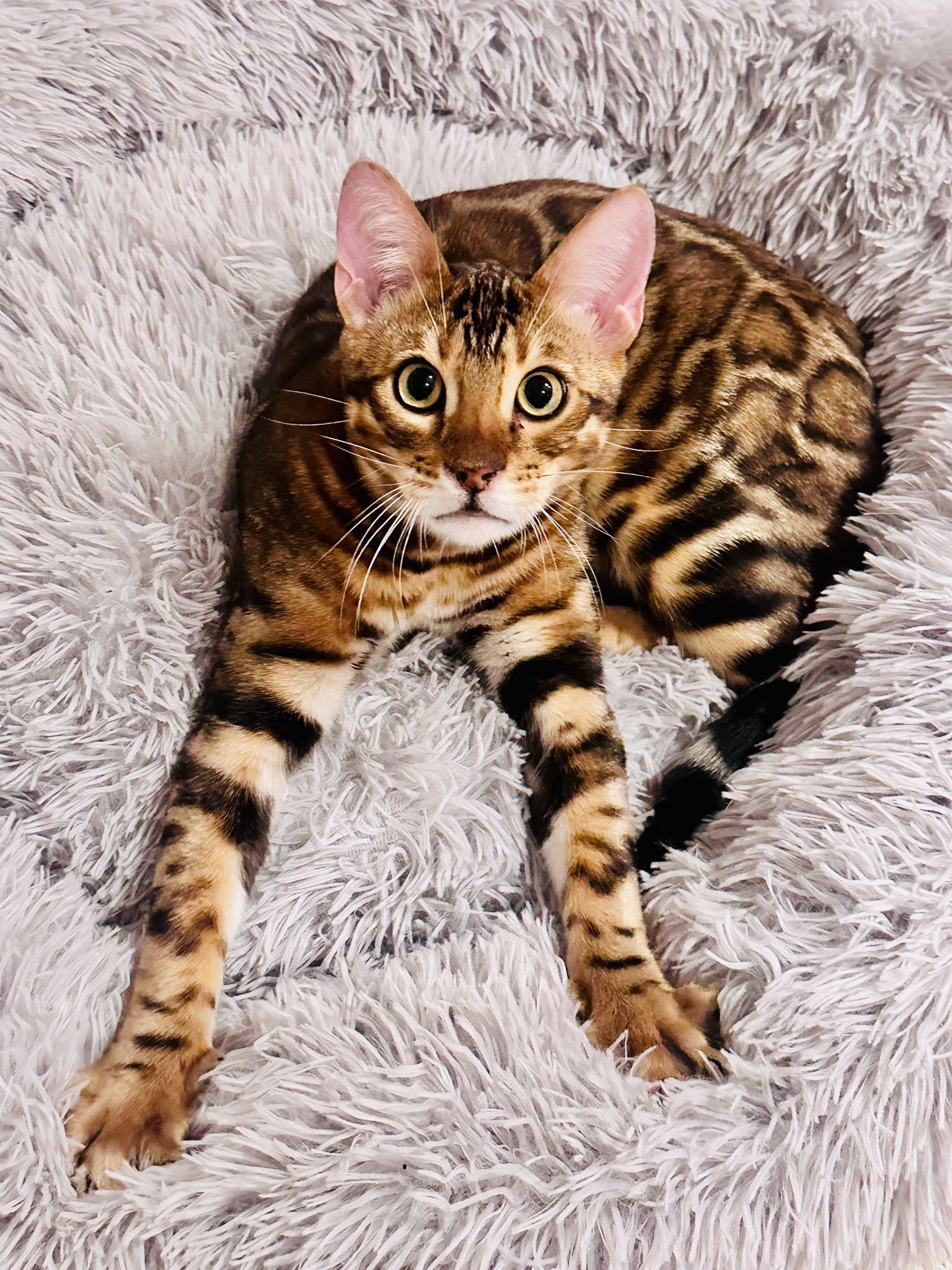Bengal cats, with their strikingly wild appearance and affectionate personalities, have captured the hearts of cat lovers worldwide. This unique breed, characterized by its leopard-like spots and playful demeanor, has a rich history that blends the wild and domestic worlds. In this blog, we will explore the origins of Bengal cats, their development as a breed, and how they have become cherished companions today.
The Wild Beginnings
The story of Bengal cats begins with the Asian leopard cat (Prionailurus bengalensis), a small, wild feline native to Southeast Asia. Known for their beautiful spotted coats, these wild cats were admired for their exotic appearance. In the mid-20th century, there was growing interest in creating a domestic cat that retained the striking looks of the Asian leopard cat but possessed the temperament of a household pet.
The Birth of a New Breed
The Bengal cat breed as we know it today started with the pioneering work of Jean Mill (née Sudgen), an American breeder and conservationist. In the 1960s, Jean Mill embarked on a project to create a domestic cat with the appearance of a wild leopard. She acquired an Asian leopard cat and successfully bred it with a domestic shorthair cat. This crossbreeding produced a litter of hybrid kittens, marking the beginning of the Bengal breed.
Jean Mill’s initial goal was not only to create a beautiful breed but also to raise awareness about the plight of wild cats and discourage the keeping of wild animals as pets. By offering a domestic alternative that resembled wild cats, she hoped to reduce the demand for wild cat ownership.
Early Challenges and Progress
The early generations of Bengal cats, known as F1 (first generation) hybrids, were a mix of wild and domestic traits. These early hybrids often exhibited the aloofness and independence of their wild ancestors, making them less suitable as pets. However, through careful selective breeding, subsequent generations (F2, F3, and beyond) became more domesticated in their behavior while retaining the striking appearance of the Asian leopard cat.
Jean Mill’s dedication and perseverance paid off, and by the 1980s, the Bengal cat breed began to gain recognition. Other breeders joined the effort, and the Bengal cat gene pool expanded, improving the breed’s overall health and temperament.
Recognition and Popularity
The Bengal cat breed received formal recognition from The International Cat Association (TICA) in 1983, marking a significant milestone in the breed’s history. This recognition helped legitimize the breed and attracted more breeders and enthusiasts.
In the following decades, Bengal cats gained popularity not only for their wild looks but also for their playful and affectionate nature. They became a favorite among cat lovers who wanted a unique and interactive pet. Today, Bengal cats are recognized by major cat registries worldwide, including the Cat Fanciers’ Association (CFA) and the Governing Council of the Cat Fancy (GCCF).
Characteristics of Bengal Cats
Bengal cats are known for their distinctive appearance and engaging personalities. Key characteristics include:
Coat: Bengals have a short, dense coat that comes in a variety of patterns, including spotted and marbled. Their fur often has a glittery sheen, adding to their exotic look.
Color: Common colors include brown, snow (a variant of white or cream), and silver. These colors can have various shades and patterns, creating a wide range of stunning appearances.
Build: Bengals are medium to large cats with a muscular and athletic build. They have strong legs and a sleek, streamlined body.
Personality: Bengals are known for their high energy levels, intelligence, and curiosity. They are playful, affectionate, and enjoy interacting with their human companions.
The Bengal Cat Today
Today, Bengal cats are cherished pets in households around the world. Their unique blend of wild beauty and friendly disposition makes them a standout breed. However, owning a Bengal cat requires commitment, as their high energy and intelligence demand regular mental and physical stimulation.
Bengal cats have also contributed to the field of genetics and veterinary science. Studies on their genetics have provided insights into coat color patterns and the inheritance of certain traits. Additionally, their hybrid origins have sparked discussions on animal breeding ethics and the preservation of wild cat species.
Conclusion
The history of Bengal cats is a testament to the vision and dedication of breeders like Jean Mill, who sought to create a domestic cat with the allure of the wild. From their wild origins with the Asian leopard cat to their current status as beloved pets, Bengal cats have come a long way. Their journey reflects a successful blend of conservation, selective breeding, and a passion for preserving the beauty of wild cats in a domesticated form. Whether admired for their stunning looks or cherished for their engaging personalities, Bengal cats continue to captivate and delight cat lovers everywhere.


Leave a Reply